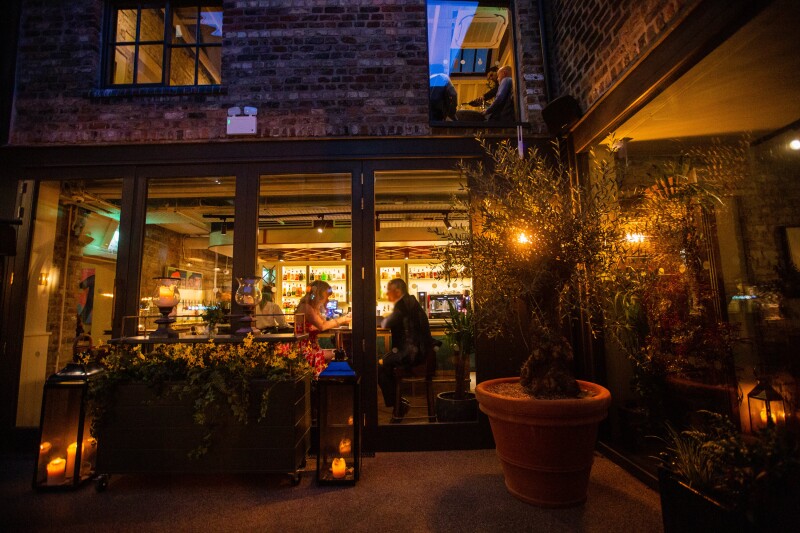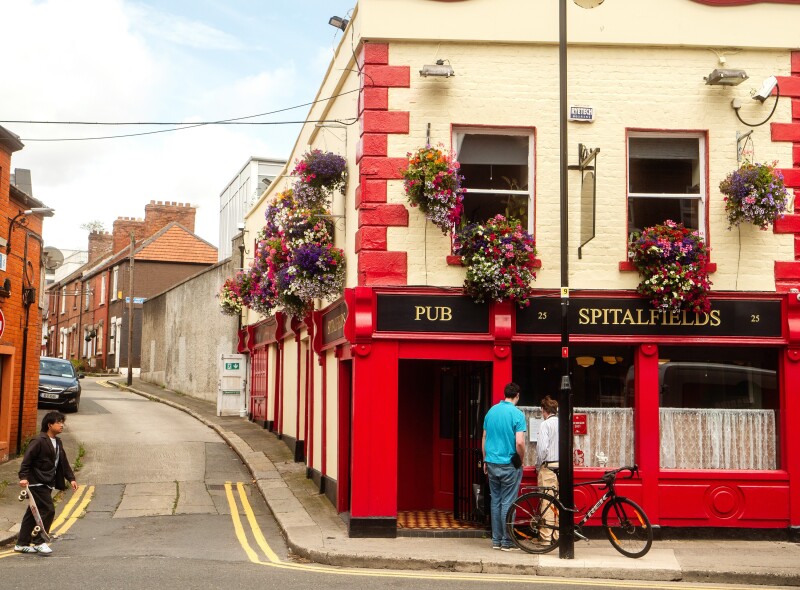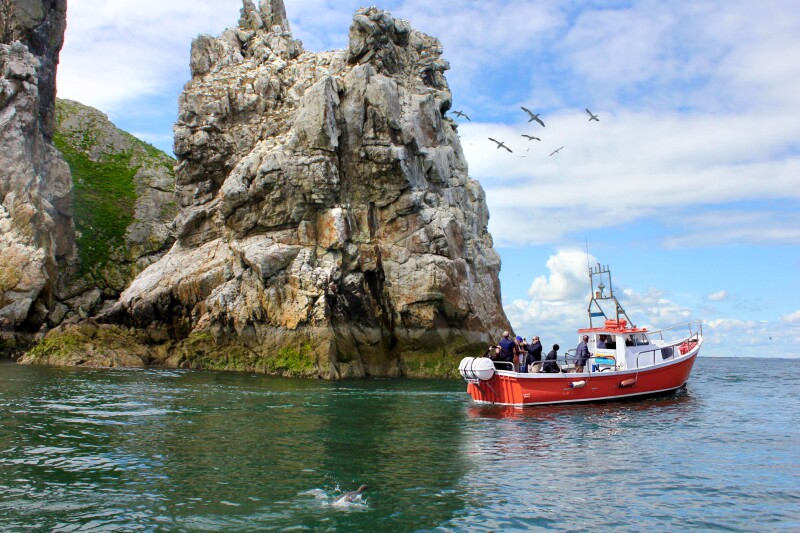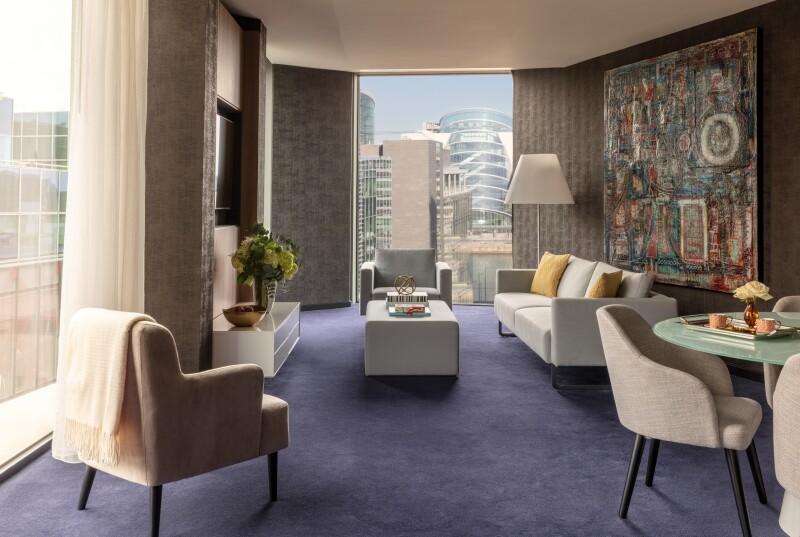Dublin is home to a quarter of Ireland’s population and there’s always lots to do—whether it’s exploring one of the national museums, browsing art galleries, having a Guinness in an 800-year-old pub, or partying at an event like the St. Patrick’s Festival in spring. The city is steeped in history, with ancient cathedrals, Viking artefacts, and 8th-century manuscripts like the Book of Kells, plus atmospheric cafés and cozy pub snugs. It’s also easy to get around on foot or by public transport (bus or Luas tram), or take the DART out of the city to see Dublin Bay or visit some of the coastal villages and beaches. This four-day itinerary runs from a Thursday to a Sunday, showing the best way to spend four days in the Irish capital.

Lennan’s Yard uses syrups, shrubs, and infusions for its inventive cocktails.
Photo By Jeff Harvey
Thursday: The city’s Georgian quarter
James Joyce’s modernist novel Ulysses famously takes the reader across Dublin city on a single day in June 1904, so one of the best places to start your cross-city odyssey is at MoLI—the Museum of Literature Ireland—based in a historic house across from St. Stephen’s Green. It’s never too crowded and exhibits change regularly. The Ink and Imagination collaboration with University College Dublin features archived manuscripts from a variety of Irish authors. Enjoy tea and scones in the garden at the Commons Café below MoLI; it backs onto the Iveagh Gardens, where the pathways of the rose garden are perfect for a peaceful stroll.
Cross St. Stephen’s Green park, with plenty of benches for people-watching, to tour the Little Museum of Dublin, where the story of the city is brought to life in a fun way in a historic house from 1776. Exhibits are quirky: Look for the one about the DART commuter rail train, which turns 40 in 2024, or ask to see the stool (seat) made with a shutter from 11 Harcourt Terrace, which is marked by bullet holes from the 1916 Rising. The museum also has a copy of the first English edition of Ulysses open on the last page, so if you started reading the novel over at MoLI, you can now say you’ve finished reading it. . . . For eco-friendly shopping, visit Fresh Cuts Clothing on Castle Market for clothing designed in Dublin using organic cotton, or look for skincare products from Dublin Herbalists at shops like Kilkenny Design or Nourish.
Drop in to Lennan’s Yard for a Dirty Duck cocktail (duck fat–washed Tanqueray gin, Lillet Blanc, and samphire brine) in an old coach house courtyard, before exploring the carefully created sharing plates of seasonal Irish food at the buzzing Library Street. The menu might include line-caught cured mackerel with tomato or salt-crusted venison with endive, pear, and beetroot. Leave room for a sheep’s milk and marinated raspberry dessert.

Phoenix Park started life as a hunting park in the 1660s.
Gorina Anna/Shutterstock
Friday: History and the high seas
Dive into some of Dublin’s history today, starting with the Jeanie Johnston on the River Liffey quays. This is a replica of a ship that was originally built in 1847 to transport emigrants to Québec during the Great Famine (1845–49). On a tour, you can see the tight living quarters and hear stories of the treacherous conditions on Atlantic crossings.
Afterwards, continue the trail of Irish emigrants at EPIC The Irish Emigration Museum at the CHQ building, where stories of famous Irish characters in everything from sport and music to politics are told through the innovative digital exhibits.
Then walk or take the Luas tram a few stops along the quays back toward the city center. “For lunch, I love the Winding Stair beside the Ha’penny Bridge—it’s a real institution in Dublin,” says Marianna Kovacova, concierge at the Morrison Hotel on Lower Ormond Quay. “They use organic Irish produce and you also have the bookshop.” The Winding Stair menu features filling Irish cooking, with favorites like hand-smoked haddock, poached in milk with onions and white Cheddar mash, or potted Dingle Bay crab with pickled cucumber and toasted soda bread.
“Bovinity on nearby Capel Street is another favorite with Irish beef and organic produce. It’s lively and real ‘north Dublin’—it’s dark, musical, and the decor is quite quirky,” says Marianna.
A few more stops along the Luas red line is Dublin’s Phoenix Park, popular with locals for its 6.8 square miles of parkland. It’s a favorite of chef and co-owner James Moore at D’Olier Street restaurant, who lived and worked around the globe before moving to Dublin in 2022.
“We go to the Phoenix Park with our dog Ruby. We moved from New York City, where there’s people everywhere. Here you walk through the touristy part and then it’s just fields, rolling hills, and grass. It just goes on forever. You bump into wild deer cruising around. You feel like you are out of the city.” The park’s Victorian Tea Rooms date from 1896 and are good for organic coffee and tasty cakes.
But keep your appetite for the 13-course tasting menu at D’Olier Street, a relative newcomer (2022) based in a restored landmark city center building. It won its first Michelin star in February for its creative and beautifully presented dishes, such as cured hamachi (fish) with smoked eel, sesame, and kimchi; cod with basil, girolle, and chicken; or pear with cardamom and tarragon.

The Spitalifields pub is a great spot for a reviving pint of Guinness.
Photo By Mark Gusev/Shutterstock
Saturday: Old Dublin
Start the day exploring one of the city’s older parts around the Liberties area —Christ Church Cathedral dates back more than 1,000 years and a self-guided tour will take you down into the underground crypt, where you can see old manuscripts, a royal plate presented by William III in 1697, and a mummified cat and rat found in the organ pipe during renovations in 1850.
The lunchtime tasting menu at Delahunt in a converted pub on Camden Street (worth the walk of around 15 minutes) includes tasty Irish ingredients (sometimes foraged) such as sea bream crudo, blackcurrant, and jalapeño, or haddock with girolles, York cabbage, and mussels.
Visit Marsh’s Library to stand among the tall towers of ancient leather-bound books and absorb the Old World atmosphere. The library is unchanged since it was founded in 1707. End the afternoon with a Teeling Tasting Tour at Teelings Distillery to learn how whiskey is made and how Dublin was the powerhouse of world whiskey production back in the 1800s, with 37 distilleries, before sampling some of the award-winning whiskeys. Dinner at Variety Jones is a culinary treat, where the six-course sharing menu combines Irish ingredients with world flavors; try an oyster snack with Vietnamese dressing and cucumber, or barbecued monkfish with curried tomato sauce and squid.
James Moore says he enjoys Spitalfields on a night off. “We love to sit in the snug, eat nice food, and have a pint of Guinness. They have a beef cheek and oxtail in a bread roll, which comes with a side dip of bone marrow gravy. In the winter months when it’s cold and wet, it’s nice to have something hearty.” For live music, check out Vicar Street (book ahead) or Whelan’s, a favorite of indie singer-songwriters.

Ireland’s Eye Ferries offers small boat tours.
Sunday: a seaside excursion with a coastal walk
Today’s the day to see some of Dublin’s coast. Grab a fresh sausage roll, morning bun and coffee at organic sourdough bakery Bread 41, and hop on the DART train from Dublin Pearse or Tara Street for the 30-minute journey to the seaside village of Howth. Take an early morning walk on the Cliff Path Loop (before the crowds arrive). The trail leads from the harbor along the rugged cliff path (wear sensible footwear), with views over to Lambay Island, Ireland’s Eye, and Dublin Bay. The walk takes around two hours, and you’ll have worked up an appetite for Howth chowder (with cod, salmon, and smoked haddock) or the fisherman’s pie at the Abbey Tavern.
“There’s a nice seat at the top of the East Pier that gets the sun in the afternoon,” says Howth native, Sean Doran, whose family have run fish shop Dorans on the Pier for more than 60 years. “You might see the trawlers coming ashore after a day’s fishing, ferries going back and forth, or sailing boats. You’ll also see wildlife—various seagulls, cormorants, kittiwakes, maybe a gannet. Drop into Anne’s shop across the road for a ’99' ice cream cone, the best in Howth.”
In the afternoon, take a one-hour boat trip from Howth pier around the wildlife sanctuary of Ireland’s Eye (about one mile from the harbor) with Ireland’s Eye Ferries, to spot local seals and nesting seabirds like guillemots, gannets, puffins, and gulls. Book an early evening table at neighborhood bistro Mamó, for fresh Irish ingredients cooked with a modern European take—try Winetavern farm pork loin and ribs, or stuffed Irish sea brill with langoustine. “The hospitality there is awesome,” says James Moore from D’Olier Street. “We sit there for four hours on a Sunday, looking out at the ocean. We always order about 90 percent of the menu.”

Anantara offers 187 guest rooms and suites and a spa with infinity pool.
Where to stay
For a taste of Georgian-style luxury, the townhouse bedrooms in the Main House of the Merrion Hotel are decorated in 18th-century style with rococo plasterwork and marble fireplaces. The hotel is steps away from many museums and galleries. And don’t miss afternoon tea in the hotel’s beautiful Georgian drawing rooms after exploring.
Anantara the Marker Dublin on Grand Canal Square in the south docklands offers a peaceful retreat, with locally inspired dishes at Forbes Street by Gareth Mullins, a spa and indoor infinity pool, plus views from the rooftop bar over the nearby docklands and as far as the Dublin Mountains.
The Morrison Hotel on Lower Ormond Quay is a luxury bolthole right in the action of the city center. Some of the bedrooms look over the River Liffey, as does the Morrison Grill, where you can people-watch over the quays from the huge windows while tucking into a juicy Josper-grilled steak or sipping a Bow Street Julep, made with whiskey from the nearby Jameson distillery on Bow Street.











